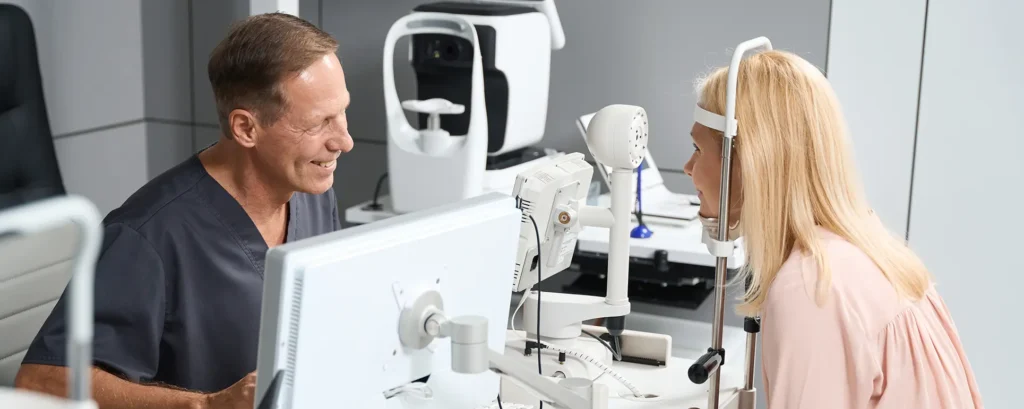If you’ve had surgery for a retinal detachment in the past, you may already know that your eye has been through a lot. While the main goal of that operation was to save your sight by repairing the retina, it’s very common to later develop a cataract — sometimes sooner than you might expect. The good news is that cataract surgery can still restore clarity to your vision, but it isn’t a straightforward, one-size-fits-all procedure. Your surgeon will need to carefully plan the timing, technique, and aftercare to protect your retina while giving you the best possible visual outcome.
In this guide, we’ll explore why cataracts often follow retinal detachment surgery, how your eye surgeon evaluates your retina before proceeding, the potential risks and extra precautions involved, and what recovery might look like for you.
Why Cataracts Are Common After Retinal Detachment Surgery
A cataract is a clouding of your eye’s natural lens, and it can happen naturally with age — but in eyes that have undergone retinal detachment repair, it can develop much faster. There are a few reasons for this. Firstly, if you had vitrectomy surgery, the gel inside your eye (vitreous humour) was removed. This changes the oxygen balance inside the eye, which can accelerate lens clouding. Secondly, if gas or silicone oil was used to help reattach the retina, these materials can also contribute to earlier cataract formation. Finally, any eye surgery causes some inflammation, and in sensitive eyes, that can speed up the process.
It’s not unusual for people who have had a retinal detachment repaired to notice vision becoming hazy or colours looking dull within a year or two — sometimes even within months — of the procedure. Recognising this early is important, as leaving the cataract too long can make surgery more challenging.
Pre-Surgery Retinal Assessment

Before going anywhere near cataract surgery, your eye surgeon will first make sure your retina is healthy and stable. This isn’t just a quick look — it often involves a thorough dilated retinal examination, sometimes supported by imaging such as optical coherence tomography (OCT) or wide-field fundus photography. If you’ve had silicone oil left in the eye, the surgeon will also consider whether to remove it during cataract surgery or leave it in place.
Your retina specialist and cataract surgeon (sometimes the same person, sometimes different) will assess for signs of new retinal tears, scar tissue (proliferative vitreoretinopathy), or traction that could put you at risk of another detachment. The aim is to reduce any chance that the act of performing cataract surgery could disturb the delicate retinal repair.
Timing the Procedure
Timing is everything. If your retinal detachment surgery was recent, your surgeon may recommend waiting at least three to six months — sometimes longer — before performing cataract surgery. This allows the retina to fully heal and reduces the risk of it detaching again. That said, if your cataract is so advanced that it’s preventing proper monitoring of the retina, the surgery may need to happen sooner.
In some cases, cataract surgery and silicone oil removal are performed together in a single operation, particularly if the oil is no longer needed and the lens has already clouded. Your surgeon will weigh up the pros and cons of this combined approach versus staging the procedures separately.
Special Surgical Considerations

Cataract surgery in an eye that’s had a retinal detachment repair can be trickier than standard cases. The surgeon must be prepared for issues such as:
- Weaker lens capsule or zonules — Past surgery or trauma may have made the lens support structures less stable, which requires a more delicate technique.
- Limited view — If there’s scarring or silicone oil in the eye, the view of the lens and retina may be less clear, requiring extra precision.
- Previous vitrectomy effects — Without the natural vitreous gel, fluidics during surgery behave differently, so settings on the phacoemulsification machine may need adjusting.
Your surgeon will also plan the incision and lens implant type carefully. In most cases, a standard monofocal intraocular lens (IOL) is chosen to minimise complications, but your preferences and overall eye health will be considered.
Section 1: How Past Retinal Surgery Affects IOL Power Calculations
One of the more subtle challenges in cataract surgery after retinal detachment is accurately calculating the power of your intraocular lens (IOL). This matters because the lens implant is what determines your long-term focusing ability, and you only get one chance to get it right. If your eye has been operated on before, the shape and length of the eye can change slightly — especially if a scleral buckle was used during your retinal repair. These changes can throw off the standard formulas that surgeons use for IOL calculations.
To get around this, your surgeon will often use more than one measuring method, such as combining optical biometry with ultrasound measurements, and may cross-check results with historical data from before your detachment. In eyes with silicone oil, light doesn’t pass through the same way, so special settings are used to compensate for the altered optical path. All of this means your lens power choice is tailored to your eye’s unique history, rather than relying on a one-size-fits-all calculation.
Getting this step right can make the difference between needing glasses all the time and enjoying good distance or near vision without correction. It’s one reason why post-retinal detachment cataract surgery is best done by an experienced surgeon who is comfortable with these more complex calculations.
Risks to Be Aware Of
While most people do very well, cataract surgery after retinal detachment repair does carry a slightly higher risk profile compared to routine cataract cases. These risks include:
- Retinal redetachment — The most significant concern, though still relatively rare if the retina is stable before surgery.
- Macular swelling (cystoid macular oedema) — More common in eyes that have already had retinal surgery, but treatable with medication.
- IOL calculation challenges — Past surgery can slightly alter the shape of the eye, making lens power prediction trickier.
- Infection and inflammation — Standard surgical risks, but sometimes recovery is a bit slower in previously operated eyes.
Understanding these risks ahead of time allows you and your surgeon to plan how to minimise them.
Recovery and Monitoring

Recovery after cataract surgery in a post-retinal detachment eye is generally similar to any other cataract procedure — you’ll have eye drops for a few weeks, avoid heavy lifting, and wear a protective shield at night initially. However, your follow-up schedule may be more frequent, especially in the first few weeks, so your surgeon can monitor the retina closely.
It’s normal for your vision to improve gradually, but your final visual outcome will also depend on how healthy your retina is. If the detachment affected your central vision (macula), you may not achieve perfect clarity — but removing the cataract can still make a significant difference.
Lifestyle Considerations Before and After Surgery
When you’ve already been through one major eye operation, it’s normal to feel cautious about what comes next. That’s why preparing your lifestyle before cataract surgery — and making sensible adjustments after — is so important. In the weeks leading up to your procedure, it’s worth arranging any help you might need for daily activities, especially if your vision is already quite reduced. Things like food preparation, transport to appointments, and managing household chores can be more difficult in the immediate recovery period.
After surgery, your surgeon will give you specific instructions about activity restrictions. While you don’t have to spend weeks doing nothing, you will need to avoid heavy lifting, dusty environments, and activities that put pressure on the eye, like vigorous bending or straining. If you enjoy exercise, gentle walking is fine almost straight away, but gym workouts, swimming, and contact sports should wait until your surgeon gives the all-clear.
It’s also worth planning your work schedule, especially if your job involves screen use, bright lights, or eye strain. Taking a few days to gradually return to your usual pace allows your vision to adjust more comfortably. Looking after your general health — eating well, staying hydrated, and following your prescribed eye drop routine — gives your eye the best chance of healing smoothly and keeping your retina safe.
Frequently Asked Questions
- How long should I wait after retinal detachment surgery before having cataract surgery?
In most cases, surgeons recommend waiting at least three to six months after retinal detachment repair before undergoing cataract surgery. This gives your retina enough time to heal and stabilise, which reduces the risk of disturbing it during the cataract procedure. However, if your cataract is already so dense that it’s stopping your doctor from properly checking your retina, your surgeon may suggest bringing the surgery forward. - Will cataract surgery increase my risk of another retinal detachment?
There is a slightly higher risk compared to someone who hasn’t had retinal surgery, simply because the retina has already been weakened and repaired once. That said, if your retina is stable and your surgeon uses careful techniques, the chance of another detachment is still relatively low. Your surgeon will always weigh the benefits of improved vision against the small risk of recurrence. - Can I have cataract surgery if silicone oil is still in my eye?
Yes, it is possible to perform cataract surgery with silicone oil in place, but your surgeon will consider whether it’s better to remove the oil at the same time. In some cases, doing both procedures together makes sense, especially if the oil is no longer needed for retinal support. In other situations, it’s safer to leave the oil in until the retina is stronger. - Will my vision be perfect after surgery?
That depends on the health of your retina. If your macula — the part of the retina responsible for sharp central vision — was damaged during the detachment, your vision may still have some limitations. Even so, removing the cataract can significantly improve clarity, contrast, and brightness, which often makes everyday tasks much easier. - What type of lens implant will I get?
Most people in this situation are best suited to a monofocal intraocular lens (IOL). This type of lens is reliable and minimises optical side effects, which is important in an eye that’s already had complex surgery. Premium lenses like multifocals are usually avoided unless your retina is in excellent condition. - Does past retinal surgery make cataract surgery more difficult?
Yes, it can. Retinal surgery may have weakened the structures that hold the lens in place or altered the way the eye behaves during surgery. Your surgeon will adjust their approach to handle these challenges, using special techniques and equipment to keep the procedure safe and effective. - Is recovery longer after cataract surgery in these cases?
The basic healing time for the incision and the lens settling in is similar to standard cataract cases. However, because your eye has a history of retinal problems, your surgeon will want to monitor you more closely for the first few weeks — and sometimes months — after surgery to ensure the retina remains stable. - Can cataract surgery be combined with other eye procedures?
Yes. In some cases, cataract surgery is combined with silicone oil removal or even additional retinal work. This decision depends on the strength of your retina, the urgency of removing the oil, and the condition of your lens. Combining procedures can reduce the number of times you need surgery, but it’s not always the safest option. - How will I know if my retina is stable enough for cataract surgery?
Your surgeon will carry out a detailed dilated retinal examination, and may also order OCT scans or wide-field retinal imaging. They’ll be looking for signs of any new tears, scar tissue, or areas of traction that could make surgery riskier. Only when your retina passes this check will surgery be scheduled. - What warning signs should I look out for after surgery?
After cataract surgery, you should seek urgent medical help if you notice sudden flashes of light, a new shower of floaters, or a dark shadow or curtain moving across your vision. These could indicate a retinal tear or detachment, and early treatment is critical to saving your sight.
Final Thoughts
Having cataract surgery after retinal detachment repair is absolutely possible — and for many people, it’s the step that brings back clearer, more comfortable vision. The key is working with a surgeon who understands the unique needs of your eye, takes the time to assess your retina carefully, and plans the procedure with your safety as the top priority. At the London Cataract Centre, we regularly help patients in this exact situation, tailoring surgery to protect both the clarity of your lens and the health of your retina.
References
- Cole, C. and Charteris, D. (2009) ‘Cataract extraction after retinal detachment repair by vitrectomy: visual outcome and complications’, Eye, 23, pp. 1377–1381. Available at: https://www.nature.com/articles/eye2008255
- Morano, M.J. et al. (2023) ‘Incidence and risk factors for retinal detachment after cataract surgery’, Ophthalmology Science. Available at: https://www.ophthalmologyscience.org/article/S2666-9145%2823%2900046-5/fulltext
- Momenaei, B. (2024) ‘Retinal tear and retinal detachment after cataract surgery: impact of interval since detachment repair’, American Journal of Ophthalmology Retina. Available at: https://www.aaojournal.org/article/S0161-6420%2824%2900392-0/abstract
- Forsell, S. et al. (2018) ‘Frequency of retinal redetachment after cataract surgery’, Ophthalmology Retina, 2, pp. 259–263. Available at: https://www.ophthalmologyretina.org/article/S2468-6530%2817%2930106-9/fulltext
- Olsen, T. (2012) ‘The incidence of retinal detachment after lens surgery’, Journal of Cataract and Refractive Surgery, 38, pp. 1916–1920. Available at: https://pmc.ncbi.nlm.nih.gov/articles/PMC3447164/

